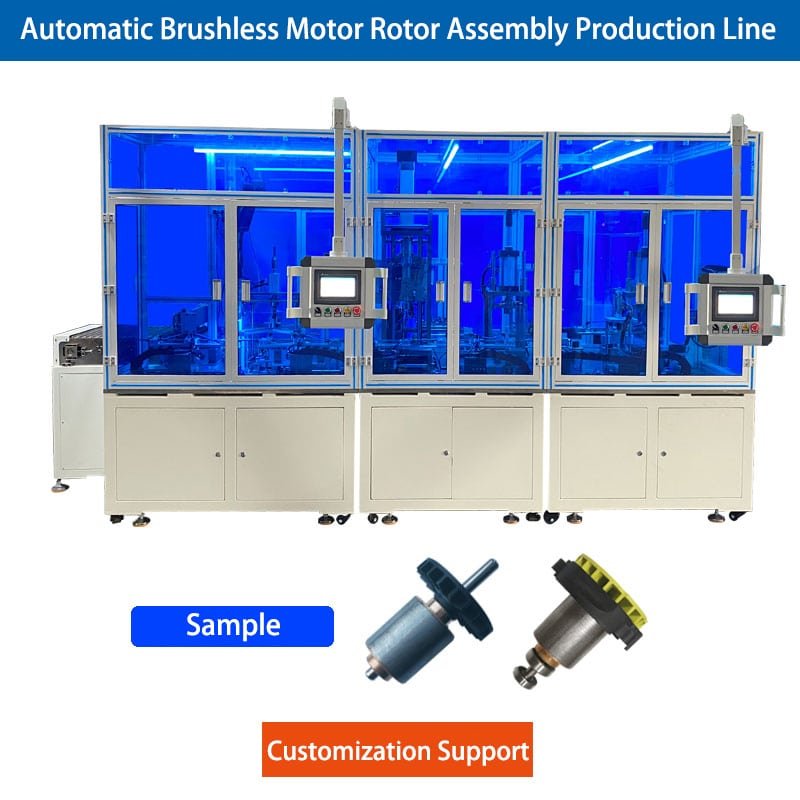The customization and solution planning of rotor automation production line is a comprehensive process covering many aspects of knowledge. It is meticulous and complex and requires our in-depth discussion. Vacuz’s reorganization and detailed interpretation of this process hope to help everyone!

Produktionslinje för motorer
1. Overview of customization needs
1. Production efficiency and capacity planning:
The construction of the production line must first meet the production efficiency and capacity requirements of the enterprise, which is closely related to the enterprise’s order volume, production cycle and market demand. We must accurately calculate the cycle time of the production line, that is, the time interval between the output of each rotor, to ensure that the production line can deliver orders on time and meet market demand.
2. Product quality and precision requirements:
The machining and assembly accuracy of the rotor directly determines the performance of the motor. Therefore, the production line needs to be equipped with high-precision sensors and testing equipment to monitor dimensions, electrical parameters, etc. in real time to ensure product accuracy. At the same time, the production line should have the ability to automatically correct or remove unqualified products to ensure product quality.
3. Equipment reliability and stability considerations:
The reliability and stability of the equipment are the key to production continuity. It is crucial to select a reputable equipment supplier and evaluate its ability to operate under different environmental conditions. The equipment needs to adapt to the production environment with large changes in temperature, humidity, etc. to ensure stable production.
4. Flexibility and scalability design:
The production line needs to have sufficient flexibility and scalability to meet the production needs of rotors of different models and specifications. The equipment should be easy to add, modify or replace, reduce adjustment costs and improve production efficiency.
5. Safety and environmental standards:
The production line needs to be equipped with complete safety protection devices, such as emergency stop buttons, guardrails, light curtain sensors, etc., to ensure the safety of operators. At the same time, the production process must comply with local environmental protection regulations and pay attention to issues such as waste disposal, noise and exhaust emissions.
2. Program planning steps
1. Demand analysis deepening:
In-depth understanding of the company’s production needs, product specifications, production capacity requirements, etc., to provide accurate demand input for customized production lines.
2. Technology evaluation and innovation:
Evaluate existing technologies and determine technologies that can be used for production line customization. At the same time, consider adopting new technologies or improving existing technologies to improve production efficiency and product quality.
3. Equipment selection and supplier selection:
Based on the results of demand analysis and technical evaluation, select appropriate equipment suppliers and models. Ensure that the selected equipment meets the customization requirements and has good reliability and stability.
4. Layout design and optimization:
Carry out layout design according to the process flow and equipment selection results. Ensure that the components of the production line are smoothly connected to facilitate assembly and later maintenance.
5. Real-time monitoring and feedback mechanism:
Set up real-time monitoring equipment on the production line to monitor each process in real time. Unqualified products should be fed back and processed in time to ensure product quality and production efficiency.
III. Overview of required professional knowledge
1. Mechanical design and manufacturing technology:
Understand the design, manufacturing and assembly process of mechanical parts, and master the selection and application of key components such as precision ball screws, guide rails, and cylinders.
2. Automation control technology:
Be familiar with the working principles and applications of automation control equipment such as PLC and servo drives, and understand the application and debugging methods of sensors, detection equipment, etc. in production lines.
3. Safety and environmental protection regulations:
Master local production safety regulations and environmental protection regulations, and understand how to set up safety protection devices and production processes that meet environmental protection requirements on the production line.
4. Production management and optimization strategy:
Be familiar with the scheduling, production scheduling and optimization methods of the production line, and understand how to improve production efficiency and product quality through data analysis, lean production and other methods.

Automatisk produktionslinje för montering av borstlös motorrotor
In summary, the customization and program planning of the rotor automation production line requires comprehensive consideration of multiple factors, and mastering relevant mechanical design, automation control technology, safety and environmental protection regulations, and production management and optimization knowledge. Through scientific demand analysis, technical evaluation, equipment selection, layout design, and real-time monitoring and feedback, we can ensure that the customization requirements and programs of the production line meet the production needs of the enterprise and improve production efficiency and product quality.
E-post: sales@vacuz.com





